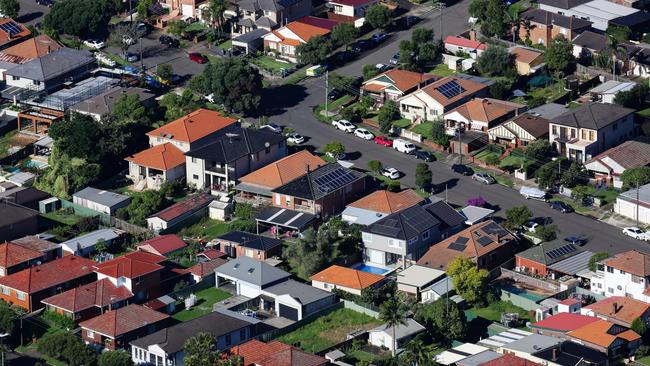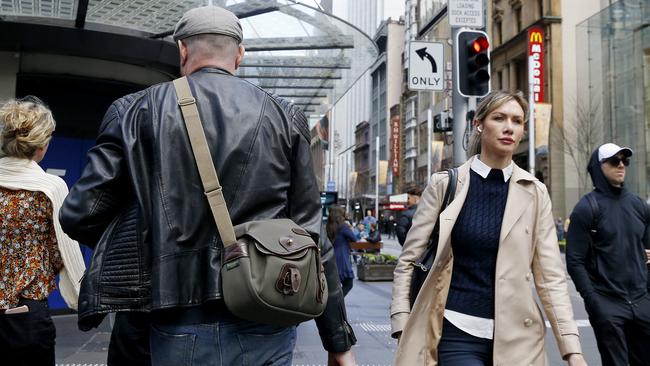Election spendathon, inflation rate sees Aussies pay more on their mortgages
Struggling mortgage holders will get a rate cut in May, but are now tipped to get less over the rest of 2025, an industry expert warns.
Business Breaking News
Don't miss out on the headlines from Business Breaking News. Followed categories will be added to My News.
Households may face higher than expected mortgage rates as Wednesday’s inflation reading and an election spendathon is likely to impact interest rates, experts have warned.
According to AMP chief economist Shane Oliver Australians will still get a rate cut in May, but the total pace or rate reductions is likely to slow.
“The most likely outcome is they (the RBA) cut in May by 25 basis points, then cut in August by 25 basis points and possibly cut in November, but there will only be at most three this year,” he said.
“Whereas if I look at the money market it is saying four by November, which is probably a bit much, but I would concede we could have four by February 2026.”

This comes as just a few weeks earlier some were calling for an emergency 50 basis point rate cut immediately as well as up to 5 rate cuts by the end of the year on the back of US President Donald Trump’s tariffs on just about every trading partner.
The US President later paused tariffs for 90 days on every country excluding China.
“Markets often overreact, if you go back a few weeks some were talking about an emergency meeting to make a 50 basis point cut. You could argue that was over the top,” Dr Oliver said.
Dr Oliver also flagged Australia’s all important trimmed mean inflation rate which came in at 0.7 per cent on Wednesday, higher than markets forecasts.
“The numbers weren’t bad, but weren’t as good as some were hoping,” he said.
“It was only 0.1 per cent higher, which you could argue is neither here nor there, but at the margins it has affected expectations on how much and how quickly the RBA will cut.
CBA economist Gareth Aird agrees, saying there is a “risk” the RBA could hold interest rates.
Previously labelling a May rate cut as a “done deal” if the figures came in line with his banks expectations, Mr Aird said the trimmed inflation was “a touch firmer” than the bank’s forecast of 0.6 per cent, which was also in line with the consensus of economists.
“The inflation data [released on Wednesday] is essentially in line with the RBA’s forecasts and therefore the Board will consider the prices side of the economy evolving in line with its expectations,” he said.

“The case to normalise the cash rate to a more neutral setting remains, but we maintain that the Board will take a gradual approach in cutting rates despite CBA recently downgrading its forecast for the global economy.”
Mr Aird also said he was still expecting a rate cut in May.
If the two economists are correct, data by Canstar suggests borrowers with a $600,000 loan with 25 years remaining will save $91.
Dr Oliver also took aim at the “spendathon” from both parties saying higher spending increases inflation, meaning households spend more on their mortgages.
In an update earlier this week S and P warned Australia’s AAA credit rating faces pressure as soaring election promises and structural spending pushes the Australian deficit to post-GFC levels.
“Both sides of politics have engaged in a spendathon which has motivated S and P to come out and say it could lead to a credit downgrade,” Dr Oliver said.
“If the budget deficit blows out in a big way that means the government is competing with everyone else to borrow money in the economy and that pushes up interest rates, impacting households and business costs,” Dr Oliver said.

“If the rating agencies look at that and downgrade Australia, then the government will pay more for borrowing as government bond yields rise, which means when the banks borrow money they will have to pay more and that will be passed onto households.”
Dr Oliver conceded both sides of politics would likely find budget savings to make sure Australia keeps its AAA rating.
“We are adding to debt and going back into a budget deficit which adds to debt, but our deficit is trivial compared to other countries,” Dr Oliver said.
“It may come in better. The numbers we have up until March are actually better than projected in the May budget.
“Australia’s debt is 30 odd per cent of GDP, while in the US and elsewhere it’s above 100 per cent of GDP.
“It remains a third or a half compared with other countries, so the risk isn’t as great.
Labor Treasurer Jim Chalmers says he will save $7.2bn in budget blowouts through cuts in the public sector, while the Liberal Party will announce its numbers later on Thursday.
Originally published as Election spendathon, inflation rate sees Aussies pay more on their mortgages


